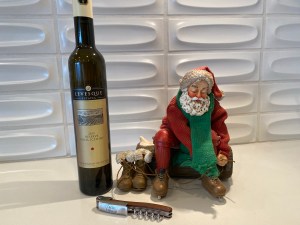German Dessert White Ice Wines Dark Blue Bottle Given to Us in 1998
Fast facts:
- 2019 Levesque Estates Reserve Vidal Ice Wine, VQA Niagara On the Lake, Canada $14.99 (@Trader Joe's; California)
Before my wife and I relocated to California, we lived in Bolton, Massachusetts. You'd be forgiven for not knowing where this town is located. Carved out of the woods in Central Massachusetts, most people in the state were unfamiliar with it at the time. That is, unless they visited there during the fall apple picking season, for the town was "famous" for its orchards. This gave rise to a winery called Nashoba Valley Winery, which specialized in fruit wines. These wines (I use the term loosely) were crafted from apples, pears, cranberries, peaches, apricots and blueberries, sometimes combinations thereof.
It was a tradition of ours to enjoy their apricot wine while decorating our Christmas tree. So we have a strong association between the holidays and sweet wines, although we have moved away from the apricot wine to things like port wine, limoncello and ice wine.
This one from Trader Joe's would be a perfect complement not only to tree decorating, but to your dessert table, or – as a dessert wine – could be dessert itself!
You may be surprised to learn that Icewine (the anglicanization of the German Eiswein) is the most famous wine produced in Canada. Heck, for all I know, you might be surprised to hear that Canada produces wine at all. (Give it time, climate change may help Canada produce Cabernet Sauvignon that tastes like it came from Napa in a few short decades.)
But speaking of surprises, I was surprised to discover this Canadian Icewine tucked in next to the Chardonnay at my local Trader Joe's last week. If you have never tried Icewine, you're in for a sticky sweet treat. And if you have purchased Icewine in the past, you'll be pleased to know that at $14.99 (for a 375ml half-bottlel) this brand from Traders sells for a third of the price of the brands that are the more 'famous" ice wines from this region. But that doesn't mean that it is one third less delicious…

Tasting Notes:
Pours a medium golden yellow. In the glass, clean and focused aromas of tropical fruit including mango and pinepapple. On the palate fruit flavors including peach, nectarine and lemon are balanced by a crisp, lively acidity. Perfect on its own, it would also pair really well with a variety of cheeses (blue veined, aged cheddar, rich cream cheeses served with marcona almonds and dried fruits); seared scallops; lobster; rich pates; and fruit based desserts. Delicious!
In general terms, there are two types of dessert wines: fortified wines and those that are not fortified. Since "adult beverages" are made by yeast (all hail yeast!) converting starches and sugars into alcohol, if there is sugar left behind, the producer can either leave it as a sweet, low alcohol elixir, or add neutral grain spirits to jack the alcohol level up to that of table wine and beyond. This featured Ice Wine (unfortified) is just 10.25% alcohol. Port wines on the other hand, ARE fortified and can clock in around 20% alcohol by volume (ABV).
Sweet wines are sometimes made by extracting water from the wine. In other cases, they are the result of arresting the fermentation process before the yeast has converted all of the sugars to alcohol. Some of the most famous wines in the world are sweet, but they do not all become sweet the same way!
In the case of the French wine Sauternes, the concentration of the wine is the result of a fungus (Botrytis cinerra, if you must know, or what is referred to as "Noble Rot") that attacks the grapes very late in the growing season, and causes the (over) ripe grapes to weep and shrivel. The most famous Sauternes, which is unfortified, comes from the estate Chateau d'Yquem, south of Bordeaux.
Another very famous sweet wine is Port, which derives its name from the city of Oporto, the second largest city in Portugal, and one of our favorite wine destinations in the world. In this case, the wine is fortified with grape spirit (which is 77% ABV on its own) which serves to kill the yeast, stop the fermentation, the retain the sweetness of the unfermented wine.
In the case of Icewine, or Eiswein, the ripe grapes are left in the vineyard and subjected to freezing temperatures, which serves to freeze the water in the grapes. The grapes are then quickly pressed before the ice crystals melt, thus concentrating the flavors of the grapes sans much of their water content.
Three sweet wines, with three different methods of production, all resulting in delightfully delicious wines to enjoyed in small sips.

Santa sez: there are two things you can't do without freezing temperatures.
The first is ice skating. The second is making ice wine!
Need More Wine Picks from Trader Joe's – or Costco?
If your search for this wine lands you in Trader Joe's, take along our handy Lucky 13 list of TJ's wine here.
And if your wine shopping excursions land you in Costco, prepare by grazing our most recent reviews of Costco wines here in our Lucky 13 list.
Happy hunting.
Cheers!
Source: https://vinopointer.com/ice-is-for-skating-and-winemaking/
0 Response to "German Dessert White Ice Wines Dark Blue Bottle Given to Us in 1998"
Post a Comment